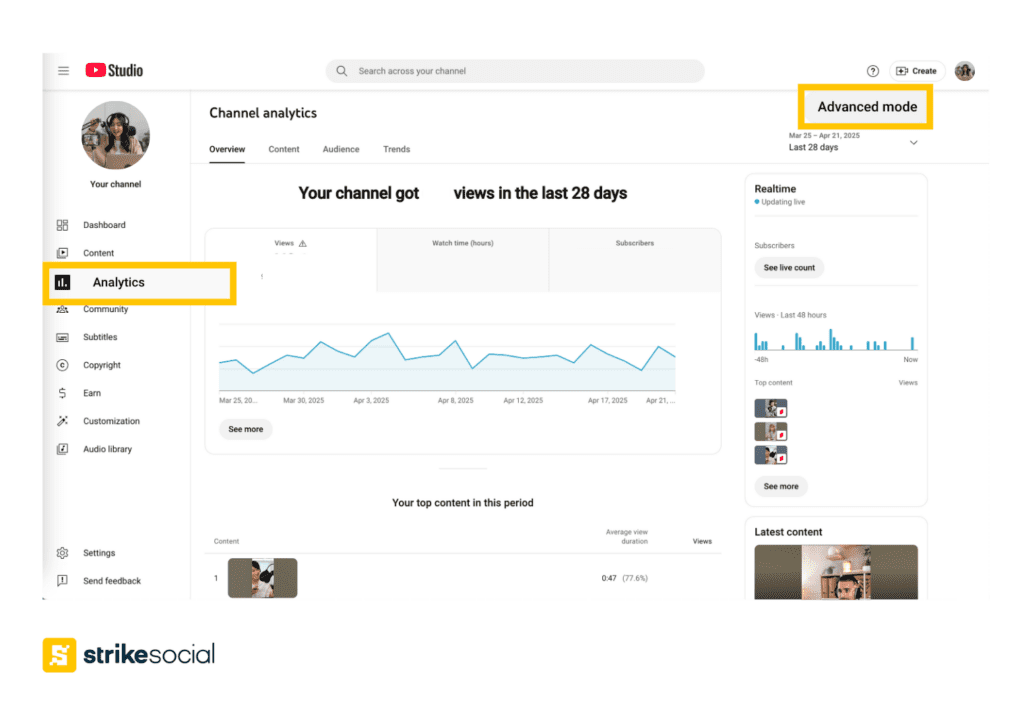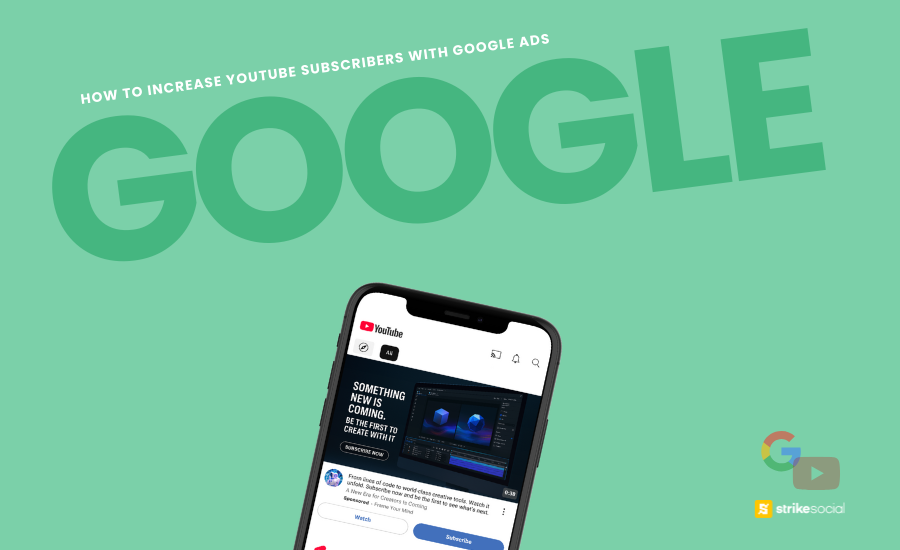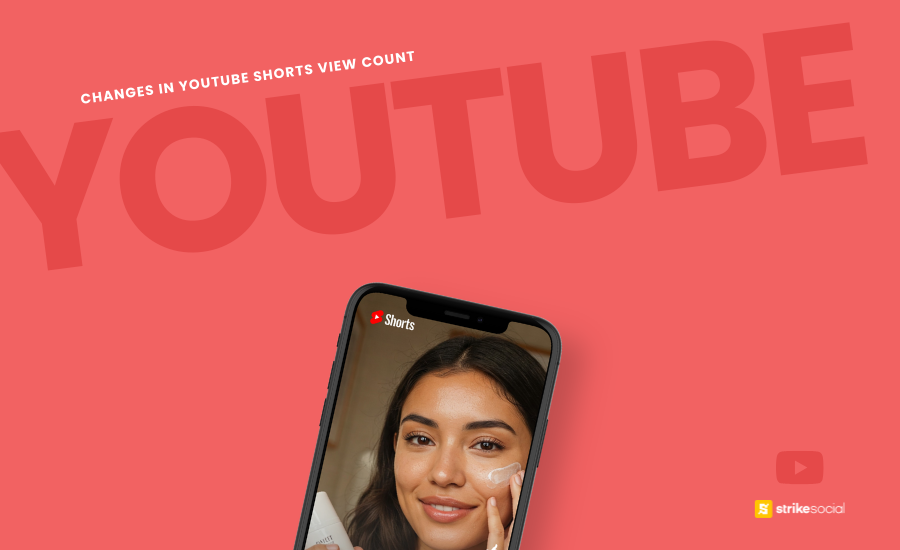Strike Overview
- YouTube Shorts view count is changing—views will now register on each play or replay, not based on watch duration, which shifts how ad performance may be interpreted.
- While monetization for creators under the YouTube Partner Program remains unaffected, advertisers must assess how these changes influence view-based performance metrics and paid media efficiency.
- With 43% of U.S. advertisers advertising on YouTube Shorts, this change may have a major impact. What should advertisers know? And if there’s a major change, how should they adapt?
Jump to Section
How the Changes in YouTube Shorts View Count Will Impact Your Paid Ads
YouTube Shorts generates more than 70 billion views daily, with the United States accounting for the largest share at 18%. As YouTube shorts views continue to grow, both creators and advertisers are competing to stay top-of-mind in an increasingly crowded space. Success now depends on aligning content and ad strategies to keep audiences engaged.
With YouTube changing how it measures Shorts views, how can brands craft smarter ad strategies to navigate this change?
How Will YouTube Shorts Count Views Going Forward?
As of March 31, 2025, YouTube announced a significant update to how YouTube Shorts views are counted—a system that had remained unchanged since Shorts launched in 2020. This shift is poised to send ripples across the platform, especially for creators and advertisers who rely on Shorts videos to grow their brands.
How YouTube Shorts Views Were Counted Before
Previously, a YouTube Shorts view was triggered when a viewer watched a video for several seconds, similar to the 30-second threshold applied to standard YouTube videos. The goal was to ensure that views on Shorts reflected genuine audience interest rather than accidental plays or quick scrolls.
What’s Changing Now
Moving forward, YouTube Shorts views will be counted each time a video is played or replayed, regardless of how many seconds it’s watched. This means even brief auto-plays, scroll-pasts, or fast replays will count as views, removing the watch-time requirement entirely.
This new metric aligns YouTube with competitors like TikTok and Instagram Reels, where short-form video views are similarly counted based on initial playbacks. Meanwhile, the older, more selective metric will still exist under YouTube Analytics as “Engaged Views,” offering creators and brands a deeper insight into quality viewership.
Why the Change Matters
This shift could lead to a sharp increase in reported YouTube Shorts views, particularly for videos with compelling hooks or repeat-play appeal. But for advertisers, it’s critical to distinguish between quantity and quality—YouTube ads on Shorts may now acquire more views that don’t necessarily reflect higher intent.
At the same time, this change allows a more direct, apples-to-apples comparison of YouTube ads with campaigns on TikTok and Instagram. For YouTube advertising focused on reach or brand awareness, the ability to benchmark performance across platforms becomes more streamlined and transparent.
Ultimately, this update emphasizes YouTube’s commitment to competing in the short-form video space. As TikTok faces ongoing regulatory challenges and Instagram expands its footprint, YouTube is reminding advertisers that Shorts is still a force to be reckoned with.
Further Reading

Thinking About Moving Your TikTok Ads to YouTube Shorts? Start Here
As YouTube cements its place as the world’s second-largest search engine, it’s quickly becoming a go-to platform for brand discovery. If you’re on the fence about sticking with TikTok, now’s the time to explore the full potential of YouTube Shorts advertising.
Impact on YouTube Users
With YouTube Shorts views now counted from when a video starts playing, concerns are mounting across the platform. Creators worry about monetization metrics, while advertisers evaluate CPVs and YouTube ad spend.
Let’s break down how this change affects both sides of the equation:
Impact on Creators
- Good news first: monetization through the YouTube Partner Program will remain unchanged. Engaged views will still be the metric used to determine monetization eligibility. For creators, the focus remains on holding viewer attention and encouraging full or repeated views.
- To differentiate Views (new view count) from Engaged views, creators can go to YouTube Studio > Analytics > Advanced Mode. The primary metric displayed will be the new view count.
- Check the box next to a specific Shorts video, and set Engaged Views as the secondary metric.


Impact on Advertisers
- While the new YouTube Shorts view count might sound like a win for exposure, it may also blur the line between views and impressions.
- For Video Views campaigns where the goal is actual viewer engagement, this change could inflate performance metrics and lead to ad spend on non-engaged impressions.
- Surface-level reporting may show higher view counts, especially in campaigns focused solely on advertising on YouTube Shorts. But without deeper analysis, advertisers risk misreading performance.
To optimize campaigns effectively, advertisers need to rethink their Shorts strategy and focus on data that reflects meaningful audience behavior.
Adapting Your Paid Ads Strategy to YouTube Shorts View Changes
With YouTube Shorts now counting every autoplay as a view, advertisers need to recalibrate how they measure performance and allocate budget. Here’s how to keep your YouTube ad strategy sharp and focused, despite the shift in view metrics:
Prioritize Engagement and Conversion
Explore the deeper metrics and benchmarks that help you better understand your campaigns. If your campaign goal is clicks, prioritize metrics like click-through rate (CTR) rather than relying on Shorts views or view rate.
For view-based campaigns, dig deeper into which placements are driving quality engagement. When working with creators, focus on Engaged views and prioritize video completion rate (VCR) to measure whether audiences are watching your ad all the way through.
Optimize Ad Creatives for the First Few Seconds
The new Shorts view metric activates on autoplay, meaning your ad’s opening 3–5 seconds matter more than ever.
Take a page from the creator playbook, such as using viral video hooks like “Have you heard about…”, “This is the best product I’ve ever used…”. Creators like Sean Andrew have seen over 13 million views with this approach, so why not put that strategy to work for your brand?
Lean Into AI-Powered Optimization
If you’re already utilizing Google’s AI-driven solutions to test and optimize different ad formats, placements, and bidding strategies, you’re already on the right track. The latest changes give you more flexibility to align your campaign goals with actual outcomes, and Google’s AI can help you make the most of that.
For example, if your YouTube Shorts ad is designed to grow your subscriber base, you no longer need to set a separate campaign just to track conversions. With Demand Gen, you can select YouTube engagements as your campaign objective and set channel subscriptions as your conversion goal—streamlining your strategy.
Even better, Demand Gen campaigns optimize for conversions and engaged views, not just reach. This means your ad spend targets high-intent viewers, not passive impressions.
Further Reading

Optimize for YouTube Subscribers Using Google Ads
In addition to generating clicks and sales, you can now effectively drive YouTube channel subscriptions using Google Ads. Thanks to Demand Gen and Google’s AI, growing your YouTube following is now significantly easier.
Segment Your Campaigns by Funnel Stage
Match your campaign objectives to your use of YouTube Shorts ads. Shorts can boost visibility at every stage, but engagement tracking now requires more careful planning.
For top-funnel campaigns like Video Reach, Shorts still deliver strong results. Impressions remain the key metric, and CPM remains the cost focus—so the new Shorts view update doesn’t shift much here.
However, for mid- and bottom-funnel efforts, greater precision is necessary. Demand Gen campaigns focused on conversions should prioritize Engaged-view conversions to track ad performance accurately. These are counted when:
- A viewer watches at least 10 seconds of a skippable in-stream ad (or the full ad if it’s shorter than 10 seconds), or
- A viewer watches at least 5 seconds of a Shorts or in-feed ad and then converts.
This distinction helps you avoid confusion from the new YouTube Shorts view system and gives you a clearer picture of ad effectiveness.
These strategies will help your paid ad efforts stay effective as YouTube Shorts continues to evolve alongside other short-form platforms.
YouTube Shorts is Changing—Don’t Get Left Behind
YouTube’s updated Shorts view counting system brings a major shift for creators and advertisers. While creators may notice minimal impact, advertisers must look beyond surface-level views and focus on true engagement to avoid misreading campaign performance.
This update is a chance to realign your strategy: prioritizing content that captures attention and ad tactics optimized for meaningful results.
Stay ahead with the latest on YouTube advertising and other paid social advertising insights. Follow us on LinkedIn and stay informed.

Article by
Syd Olivarez, Strike Social’s SEO Content Specialist
Syd crafts content on paid digital advertising strategies, blending 5+ years of writing expertise with 3 years in digital marketing. She keeps up with the latest trends to deliver valuable insights that keep brands informed and competitive.








